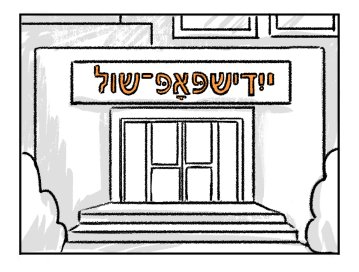
Shul — Synagogue or School?
Much of Nomi’s travails in this movie — doing poorly on an exam, not bringing a lunch, accidentally tearing her raincoat — take place at school, or שול (shul) in Yiddish. This short, simple word turns out to be far more complex than meets the eye. In fact, shul meaning school is a relatively new evolution in the history of the Yiddish language. The word’s other meaning — synagogue — was for a long time the only meaning of shul, as the modern institution of school as we know it did not exist yet. Additionally, shul for synagogue has entered the English language, and may already be a very familiar word for English-speaking Ashkenazi Jews.
Until the nineteenth century, for most Yiddish speakers education meant traditional Jewish learning and took place in institutions like the kheyder, the yeshive, and the besmedresh. In kheyder, children (usually boys) in a Jewish community were provided with a traditional elementary education; at yeshive, older boys and young men could continue their studies; and the besmedresh served as a place of study for older boys and adult men. People also gathered to pray at the besmedresh; it shared this function with the shul.
Modern and oftentimes more secular Jewish schools open to both boys and girls began to appear in Eastern Europe in the nineteenth century, strongly influenced by contemporary non-Jewish models of education. This kind of institution also came to be known in Yiddish as a shul — borrowed from the German Schule, “school” — in contrast to the kheyder and yeshive that continued to exist alongside it. From then on, the term shul had two meanings: “synagogue” and “school”.
For many Yiddish speakers, shul (synagogue) and shul (school) are homonyms that must be differentiated by context. However, in the Southern and Central Yiddish dialects, the longer-established word meaning synagogue is pronounced shil, while the word adopted more recently to refer to a modern school is pronounced shul, as it is in all Yiddish dialects. Some Yiddish speakers who do not have the shil/shul distinction in their dialect have adopted saying shil for synagogue in order to avoid homonym confusion. Even in written Yiddish, the spelling שיל (shil) can now be found referring to a synagogue. You too can use the shil/shul distinction if you find yourself wanting to be extra clear about whether you mean a shil for prayer or a shul for education.
It’s interesting to note the role that Yiddish itself played in some of the modern shuln (as in schools) of Eastern Europe between the world wars. In these schools, Yiddish was the language of instruction, and Yiddish literature part of the curriculum. An example of the role played by shuln in the development of Yiddish culture is the partnership of the Central Yiddish School Organization in interwar Poland with the YIVO Institute to formulate standardized Yiddish spelling — a standard that is used to this day, including in YiddishPOP. The yidishe shul became an institution that inspired fellowship and devotion to a cause — political (often socialist) ideals together with a deep connectedness to Jewish culture through the Yiddish language. The Holocaust brought an end to the yidishe shuln of Eastern Europe. Nevertheless, day schools and supplemental schools in places as far flung as the United States, Argentina, and Australia continued to embrace similar educational ideals.

